世纪商务英语写作训练Lesson 1
exercise1商务英语写作练习

exercise1商务英语写作练习1 Week ExercisesI. Rewrite these sentences according to 7C principles.1. They bought a bicycle in Beijing in a small shop which costs $ 25.00. (Using the Principle of Clarity)2. He was warned not to drink water even in a restaurant which had not been boiled.(Using the Principle of Clarity)3. Those who work rapidly get ill in these conditions. (Using the Principle of Clarity)4.We shall take a firm line with the firm.(Using the Principle of Clarity)5. We have begun to export our machine to countries abroad.(Using the Principle of Conciseness)6. In the event that you speak to Mr. Wood in regard to production, ask him to give consideration to the delivery schedule. (Using the Principle of Conciseness)7 .We require furniture which is of the new type. (Using the Principle of Conciseness)8. She is a fast typist. (Using the Principle of Concreteness)9. These brakes can stop a car within a short distance. (Using the Principle of Concreteness)10. We hope the equipment will be delivered to our company as soon as possible. (Using the Principle of Concreteness)11.Payment of their accounts will be made by Johnsons next week.(Using the Principle of Conciseness)12. We are shipping your order on Friday. (Using the Principle of Courtesy—“You” attitude)13.To reduce our costs, we are changing the billing system.(Using the Principle of Courtesy—“You” attitude)14. I was pleased to hear that the project was completed. (Using the Principle of Courtesy—“You” a ttitude)15. We can sell at discount prices, but we cannot permit returns of merchandise.(Using the Principle of Courtesy—“You” attitude)16. Our lone experience in the book business has enabled us to provide the best customer service possible. (Using the Principle of Courtesy—“You” attitude)II. Revise these sentences so that they are positive rather than negative.1.Unfortunately, your order cannot be sent until next week.2.To avoid the loss of your credit rating, please remit payment within ten days.3.Your misunderstanding of our January 8 letter caused you to make this mistake.4.You can not visit the plant except on Saturday.5.Our stone-skin material won’t do the job unless it is reinforced.6.Your negligence in this matter caused the damage to the equipment.7.Do not walk on the grass.8.The office is closed after four O'clock.9.Because you failed to connect the cable, the picture was blurred.10.You did not read my recent letter.III. Try to rewrite the following letter in business English.Dear Mrs. WaltersBecause you delayed so long in your response, Model GSF is off stock. If you are interested, we have some similar models on handYours truly。
商务英语写作Unit 1 An Overview of Business Letter Writing[精]
![商务英语写作Unit 1 An Overview of Business Letter Writing[精]](https://img.taocdn.com/s3/m/46a35798c8d376eeaeaa31fe.png)
related values in areas such as integrity, service, and safety to ensure that
there is
Concreteness
• Your writing should be vivid, specific and
definite rather than vague, general and abstract, especially when you are requiring a response, solving problems, making an offer or acceptance, etc.
• They have a
decided advantage in regard to freight charges
• Messrs. Smith and
Richardson have been informed that they would receive an answer in a few days.
shipment.
to 10 tea-sets in
shipment was found.
We/I attitude
You attitude
1. A large sale of our
products will make our company more profitable.
2. We are in need of fund
• This letter is to inform • Since you are our
世纪商务英语写作训练第五版第一单元课后答案

世纪商务英语写作训练第五版第一单元课后答案1. —__________________?— Sure, no problem. First, go see Cindy and tell her where you're going and when. [单选题] *A. Will the company reimburse everythingB. Will I use the card for everythingC. Can you fill me in(正确答案)2. — What does the customer's complaint say?— _________________. [单选题] *A. He says he will write us a thank-you letterB. He says he hasn't gotten back the monitor for repairs.(正确答案)C. He wants to know whether we could give him a discount3. — Could you be so kind as to turn down that rock “n” roll? I'm preparing for tomorrow's meeting report.— ______________. [单选题] *A. It's none of you businessB. No, I don't think soC. Sure. Sorry to disturb you(正确答案)4. — I had a really good weekend at the seaside.—____________. [单选题] *A. Oh, that's very nice of youB. Oh, I'm glad to hear that(正确答案)C. It's a pleasure5. — Thanks for inviting me, John, but I've already made other plans.—________Maybe another time. [单选题] *A. I hope you enjoy it.B. That's good.C. Oh! I'm sorry to hear that.(正确答案)6. —I'm really fed up with Larry!—________ [单选题] *A. I'm sorry to hear that.B. Really?C. Hey, what's up?(正确答案)7. — I thought that if I could get your support first, it might make getting approval easier. — _________ . [单选题] *A. We will need another four thousand dollars to cover the costB. Well, you've got my support on this(正确答案)C. You only need a budget increase for the first order8. —Aunt Cindy, do you shop online often?—________. [单选题] *A. No, I don't think so.B. That's a good idea.C. Yes. It's very convenient and the price is often lower than in store.(正确答案)9. —Okay, what is the decision?—As you know, we have been a privately held, family-owned company for over 120 years,_____. [单选题] *A. and I think it definitely has a bright futureB. but it may be time to consider some major changes(正确答案)C. but the company faces tough competition10. —You mean... like becoming a publicly-traded company?—That's right. ______________ . [单选题] *A. It's something we should give serious consideration to(正确答案)B. It will still be a privately held companyC. It will become a privately held company11. —I'll be away on a business trip. Would you mind signing for my express delivery?—________________. [单选题] *A. have no timeB. I'd rather notC. I'd be happy to(正确答案)12. — What is the distance between the new building and your office?— _________________. [单选题] *A. It is near to the bus stopB. It is about 15 kilometers(正确答案)C. It is very close13. —______________—Yes, I think so./Yes, business Class [单选题] *A. When do you plan to leave?B. Where shall I make hotel reservation?C. Will you fly business class?(正确答案)14. — They want to make sure you're paying taxes on the money you make.— ________ . [单选题] *A. We're paying alright(正确答案)B. At least, our records for money in are very completeC. That's something you can improve by talking to human resources15. —Are there any disadvantages to shopping online?—___________. But I think this problem will be solved soon. [单选题] *A. It makes life easyB. It takes some time for the stuff you buy online to arrive(正确答案)C. The stuffs you buy online arrives quickly.16. —We've done very well so far but if we want to see serious growth ______________.—Yeah...maybe. But I have my doubts. [单选题] *A. it might be time to stick to original business modelB. it might be time not to change company modelC. it might be time to ditch our old business model and go public(正确答案)17. —Have you ever tried shopping online?—No, never. ____________, especially for clothes and shoes. [单选题] *A. I prefer to actually see and touch what I'm buying before I pay for it(正确答案)B. I prefer not to actually see and touch what I'm buying before I pay for itC. I would rather surf online and I pay for it immediately18. —________________ , but I still have the feeling that it's not safe enough.—I couldn't agree more. That's why I only do street shopping. [单选题] *A. Paying online is much unsafe than beforeB. Paying online is less safer than beforeC. Paying online is much safer than before(正确答案)19. —Hello, Sir,___—I'd like to order a pizza. [单选题] *A. What do you do?B. How are you?C. What can I help?(正确答案)20. —__________________?— I expect to depart for Frankfurt on Sunday, September 1st, any time after 13:00 pm. [单选题] *A. How would you like to goB. Where shall I make hotel reservationC. When do you plan to leave(正确答案)21. — How would you like to go?—__________________. [单选题] *A. I'll get in touch with the railroadB. I'd like to fly to Frankfurt for a stay of two days(正确答案)C. I expect to depart for Frankfurt on Sunday, September 1st22. — How do you calculate the fee if we ask you to move the office furniture?— _________________. [单选题] *A. We can give you a 10% discountB. Sorry, we are not available these daysC. The cost depends on the floor to move to, the distance between two places and the amount of the furniture to move(正确答案)23. — How is the weather in Autumn?—_______ [单选题] *A. It is cool and windy.(正确答案)B. I like autumn.C. Yes, it is.24. —Amy, do you shop online often?— ______________. [单选题] *A. No, I don't think soB. That's a good ideaC. Yes. It's very convenient and the price is often lower than in store(正确答案)25. —Hello, this is Lucas Bowen. I'd like to order some machines.—___________. When do you need them?[单选题] *A. Sorry, I am busyB. No problem(正确答案)C. No, you can do it online26. ---Morning Maggie. Could you talk briefly about your career development?---__________. [单选题] *A.Good morning, Mr. Marx. I’m going to do a brief about my latest work and performance.B.Sure, Mr. Marx. Thanks for giving me this opportunity. I started as a clerk in this company...(正确答案)C.Sorry, Mr. Marx, but I don’t like my boss at all. I think he is too serious and critical.27. ---Good morning. __________?---Good morning! I need a check to send to my publisher in New York. [单选题] *A.What can I do for you, Madam(正确答案)B.What do you want to buy, MadamC.Why do you come here, Madam28. ---What are they? __________?--- It’s a secret. But I’ll give you some hints, anyway. [单选题] *A.Is it a secret?B.Can I have an idea about them?(正确答案)C.Why do you keep it a secret?29. ---Thanks for inviting me, John, but I’ve already made other plans. --- __________. Maybe another time. [单选题] *A. I hope you enjoy it.B. That’s good.C. Oh! I’m sorry to hear that.(正确答案)30. ---I had a really good weekend at the seaside. --- ____________________. [单选题] *A. Oh, that's very nice of you.B. Oh, I'm glad to hear that.(正确答案)C. It's a pleasure.31. —Will you go to join the club?—() *A. Yes, I want to make friends.(正确答案)B. Yes, I want to join the art club.(正确答案)C. I will join the music club.(正确答案)D. Yes, I will.(正确答案)32. —Do you know Tom?—() *A. Yes, he is our monitor.(正确答案)B. Yes, he is cool.(正确答案)C. Of course, he is handsome.(正确答案)D. Sure, he studies very well.(正确答案)33. —I’m really sorry to have kept you waiting.—() *A. It doesn’t matter.(正确答案)B. That’s OK, let’s go into the park.(正确答案)C. OK, let’s go.D. Well, be on time next time.34. —There are so many people in your house. What are you doing? —() *A. We are having a party.(正确答案)B. There is a meeting in my house.(正确答案)C. They are all my neighbors, we are just chatting.(正确答案)D. I am the host.35. —What do you usually do in your spare time?—() *A. We usually play football.(正确答案)B. I often surf the internet.(正确答案)C. I always read books in the library.(正确答案)D. I usually go shopping with my friends.(正确答案)36. —I wonder if I could use your phone.—() *A. Sorry, I’m busy.B. Sorry, it doesn’t work.(正确答案)C. No, I can’t.D. Sure ,here you are .(正确答案)37. —Sorry to trouble you, sir. I’m looking for the hospital. —Well,() *A.I’m not sure,but I think it’s over there.(正确答案)B. let me think.C.Walk down this street to the end.(正确答案)D.let me have a look.38. —I can’t finish reading the book within this week. —() *A. It doesn’t matter,you can renew it .(正确答案)B. B. Take it over .C. You’d better not .D. Take your time.(正确答案)39. —Can I borrow your color pencil?—() *A. Sorry, I don’t have any .(正确答案)B.No, it’s mine.C.Yes,here you are.(正确答案)D.I have one.40. —May I take your order now?—() . *A. No, I’m in trouble now.B. Yes, I’d like a dish of chicken.(正确答案)C. Yes, we obey orders .D.Sorry, please wait a moment.(正确答案)41. Writing.Suppose you were not satisfied with your present conditions or environment of your work, now you are asked to write to your boss about your complaints and suggestions for the development of the company you work for. (English word limit:150~250). [填空题] *_________________________________。
国际商务英语课文电子版+课后习题答案 lesson(1)

Lesson (1)International business refers to transaction between parties from different countries. Sometimes business across the borders of different customs areas of the same country is also regarded as import and export, such as business between Hong Kong and Taiwan.International business involves more factors and thus is more complicated than domestic business. The followings are some major differences between the two:1.The countries involved often have different legal systems, and one or more parties will have to adjust themselves to operate in compliance with the foreign law. 2.Different counties usually use different currencies and the parties concerned will have to decide which currency to use and do everything necessary as regards conversion etc. Uncertainties and even risks are often involved in the use of a foreign currency.3.Cultural differences including language, customs, traditions, religion, value, behavior etc. Often constitute challenges and even traps for people engaged in international business.4.Countries vary in natural and economic conditions and may have different policies towards foreign trade and investment, making international business more complex than domestic business.With the development of economic globalization, few people or companies can completely stay away from international business. Some knowledge in this respect is necessary both for the benefit of enterprises and personal advancement. International business first took the form of commodity trade, i. e. exporting and importing goods produced or manufactured in one country for consumption or resale in another. This form of trade is also referred to as visible trade.Later a different kind of trade in the form of transportation, communication, banking, insurance, consulting, information etc. gradually became more and more important. This type of trade is called invisible trade. Today, the contribution of service industries of the developed countries constitutes over 60 %of their gross domestic products and account for an increasing proportion of world trade.Another important form of international business is supplying capital by residents of one country to another, known as international investment. Such investments can be classified into two categories. The first kind of investments, foreign direct investments or FDI for short is made for returns through controlling the enterprises or assets invested in in a host country. The host country is a foreign country where the investor operates, while the country where the headquarters of the investor is located is called the home country. The second kind of investment, portfolio investment refers to purchases of foreign financial assets for a purpose other than controlling. Such financial assets may be stocks, bonds or certificates of deposit. Stocks are also called capital stocks or bonds. Bonds are papers issued by a government or a firm with promise to pay back the money lent or invested together with interest. The maturity period of a bond is at least one year, often longer, for example five, or even ten years. Certificates of deposit generally involve large amounts, say 25 thousand US dollars.Besides trade and investment, international licensing and franchising are sometimes taken as a means of entering a foreign market. In licensing, a firm leases the right to use its intellectual property to a firm in another country. Such intellectual property may be trademarks , brand names , patents , copyrights or technology. Firms choose licensingbecause they do not have to make cash payments to start business, and can simply receive income in the form of royalty. Besides, they can benefit from locational advantages of foreign operation without any obligations in ownership or management. The use of licensing is particularly encouraged by high customs duty and non-tariff barriers on the part of the host country. However, it is not advisable to use licensing in countries with weak intellectual property protection since the licensor may have difficulty in enforcing licensing agreement.Franchising can be regarded as a special form of licensing. Under franchising, a firm, called the franchisee, is allowed to operate in the name of another, called the franchiser who provides the former with trademarks, brand names, logos, and operating techniques for royalty. In comparison with the relation between the licenser and the licensee, the franchiser has more control over and provides more support for the franchisee.The franchiser can develop internationally and gain access to useful information about the local market with little risk and cost, and the franchisee can easily get into a business with established products or services. Franchising is fairly popular especially in hotel and restaurant business. Other forms for participating in international business are management contract, contract manufacturing, and turnkey project.Under a management contract, one company offers managerial or other specialized services to another within a particular period for a flat payment or a percentage of the relevant business volume. Sometimes bonuses based on profitability or sales growth are also specialized in management contracts. Government policies often have a lot to do with management contracts. When a government forbids foreign ownership in certain industries it considers to be of strategic importance but lacks the expertise for operation, management contracts may be a practical choice enabling a foreign company to operate in the industry without owning the assets.By contract manufacturing, a firm can concentrate on their strongest part in the value chain, e. g. marketing, while contracting with foreign companies for the manufacture of their products. Such firms can reduce the amount of their resources devoted to manufacture and benefit from location advantages from production in host countries. However, loss of control over the production process may give rise to problems in respect of quality and time of delivery.For an international turnkey project, a firm signs a contract with a foreign purchaser and undertakes all the designing, contracting and facility equipping before handing it over to the latter upon completion. Such projects are often large and complex and take a long period to complete. Payment for a turnkey project may be made at fixed total price or on a cost plus basis. The latter way of payment shifts the burden of possible additional cost over the original budget onto the purchaser.BOT is a popular variant of the turnkey project where B stands for build, O for operate and T for transfer. For a BOT project, a firm operates a facility for a period of time after building it up before finally transferring it to a foreign company. Making profit from operating the project for a period is the major difference between BOT and the common turnkey project. Needless to say, the contractor has to bear the financial and other risks that may occur in the period of operation.Answer the following questions:What does international business refer to? Please tell the difference between international business and domestic business.A:International business refers to transaction between parties from different countries. Sometimes business across the borders of different customs areas of the same country is also regarded as import and export.Some major differences between international business and domestic business is following:Differences in legal systemsDifferences in currenciesDifferences in cultural backgroundDifferent in natural and economic conditionsPlease explain the differences between visible trade and invisible trade. Which is becoming more and more important and accounts for an increasing proportion in international trade?A: Visible trade is the form of commodity trade. The form of transportation, communication, banking, insurance, consulting, information etc. is called invisible trade or service industries. The later is become more and more important.Can you cite some examples to illustrate cultural differences in international business? A: Cultural differences including language, customs, traditions, religion, value, behavior etc. Please elaborate on the two categories of international investment. What is their major difference?A: FDI (Foreign direct investment) is made for returns through controlling the enterprises or assets invested in in a host country. Portfolio investment refers to purchases of foreign financial assets for a purpose other than controlling. Such financial assets may be stocks, bonds or certificates of deposit.What is licensing? Why do firms sometimes choose it as a means of entering a foreign market?A: In licensing, a firm leases the right to use its intellectual property to a firm in another country. They choose licensing because they do not have to make cash payments to stat business, and can simply receive income in the form of royalty. Besides, they can benefit from locational advantages of foreign operation without any obligations in ownership or management. The use of licensing is particularly encouraged by high customs duty and non-tariff barriers on the part of the host country.What is franchising? How is it different from licensing?A: Under franchising, franchisee is allowed to operate in the name of another, franchiser who provides the former with trademarks, brand names, logos and operating techniques for royalty. In comparison with the relation between the licenser and the licensee, the franchiser has more control over and provides more support for the franchisee.What is a management contract? Under what conditions is it most applicable?A: Under a management contract, one company offers managerial or other specialized services to another within a particular period for a flat payment or a percentage of the relevant business volume. When a government forbids foreign ownership in certain industries it considers to be of strategic importance but lacks the expertise for operation, management contracts maybe a practical choice enabling a foreign company to operate in the industry without owning the assets.What is an international turnkey project? In what way is its variant BOT different from it? A: For an international turnkey project, a firm signs a contract with a foreign purchaser and undertakes all the designing, contracting and facility equipping before handing it over to the latter upon completion. For a BOT project, a firm operates a facility for a period of time after building it up before finally transferring it to a foreign company. Making profit from operating the project for a period is the major difference between BOT and the common turnkey project.。
商务英语写作Unit1
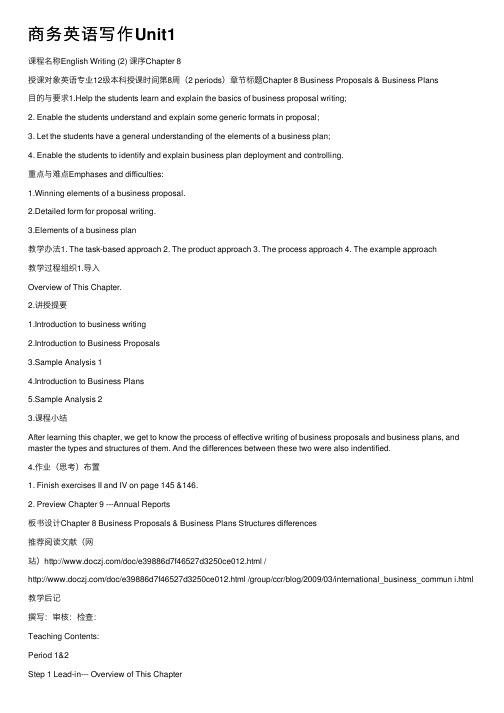
商务英语写作Unit1课程名称English Writing (2) 课序Chapter 8授课对象英语专业12级本科授课时间第8周(2 periods)章节标题Chapter 8 Business Proposals & Business Plans⽬的与要求1.Help the students learn and explain the basics of business proposal writing;2. Enable the students understand and explain some generic formats in proposal;3. Let the students have a general understanding of the elements of a business plan;4. Enable the students to identify and explain business plan deployment and controlling.重点与难点Emphases and difficulties:1.Winning elements of a business proposal.2.Detailed form for proposal writing.3.Elements of a business plan教学办法1. The task-based approach 2. The product approach 3. The process approach 4. The example approach教学过程组织1.导⼊Overview of This Chapter.2.讲授提要1.Introduction to business writing2.Introduction to Business Proposals3.Sample Analysis 14.Introduction to Business Plans5.Sample Analysis 23.课程⼩结After learning this chapter, we get to know the process of effective writing of business proposals and business plans, and master the types and structures of them. And the differences between these two were also indentified.4.作业(思考)布置1. Finish exercises II and IV on page 145 &146.2. Preview Chapter 9 ---Annual Reports板书设计Chapter 8 Business Proposals & Business Plans Structures differences推荐阅读⽂献(⽹站)/doc/e39886d7f46527d3250ce012.html //doc/e39886d7f46527d3250ce012.html /group/ccr/blog/2009/03/international_business_commun i.html 教学后记撰写:审核:检查:Teaching Contents:Period 1&2Step 1 Lead-in--- Overview of This ChapterBusiness proposals and business plans are repots that allow the audience to evaluate ideas for something new. Business proposals are often written to fill a need within or outside a business organization, while business plans primarily for bankers or potential financial supporters for a new business.Step 2 Introduction to Business ProposalsBasics of Business Proposal Writing1. The definition of a business proposalA business proposal is one kind of analytical report, written to persuade the reader to follow a plan r course of action to solvea problem, to provide services, or to sell or buy a piece of equipment. It can be written for internal or external uses.2. Types of Business Proposal⊙Internal vs. External⊙Solicited vs. Unsolicited⊙Large vs. Small3. Winning elements of a business proposal4. Channels of ProposalProblemsSolutions Benefits CredibilitySamplesTargeted Personalization⊙ Oral presentation⊙ Memo & E-mail proposals⊙ Letter proposal⊙ Business/ Technical-report proposalsGeneric Structure in Proposals1.Simple Form for Proposal Writing⊙External ProposalA.IntroductionB.Problem identified and definedC.Objective & goal setD.Solutions proposedE.Implementation & measuringF.Costs and timeframe estimated⊙Internal ProposalA.Identify the problemB.Define the problemC.Generate solutions/doc/e39886d7f46527d3250ce012.html pare costs with benefits2.Detailed Form for Proposal WritingA.Executive Summary/ AbstractIntroduce your company, what you will do or provide to the customer, andhow the customer will benefit from what you propose.B.IntroductionThe writer can begin a proposal with a sentence or paragraph. For instance,“I request permission to…” is a typical sentence-form introduction.C.Background Information (optional)D.Objective and GoalE.Feasibility of the proposed project·criteria——criteria are the standards that you apply in a feasibility studyto evaluate the alternative course of action you are considering.·method——the source of your facts will depend on the nature of yourstudy: library research, calls to manufacturers, interviews, meetings withother experts in your organization, surveys, laboratory research, and thelike.·overview of alternatives·evaluation·recommendationsF.Solution & Description of the proposed workG.ScheduleH.QualificationsDescribe your capability to do or provide what you are proposing. Relevantprior experience is usually highlighted.I.Benefits and CostsJ.ConclusionsManaging the RFP Process1.Basic Components of a RFP⊙Description of the project⊙Clearly stated needs or requirements⊙Budget⊙Time frame⊙Who has “ownership” of the project?⊙Potential risks2.Proposal EvaluationSample analysis on page 127Step 3 Introduction to Business Plans1. The definition of business planA business plan is a written proposal that allows potential supporters to evaluate ideas for a new business venture. It is often written for financial institutions, consulting firms, or business partners to seek funding, resources or cooperation.A business plan differs from a business proposal in that the former is created for the purpose of starting a new venture, while the latter is for various purposes, such as biding for a contract, selling a new product, adopting a new production method, or purchasing new equipment.2. Business Planning ProcessBusiness planning is the process of developing and analyzing the organization’s mission, overall goals, general strategies, and allocating resources.⊙Define the MissionA mission is the purpose of the organization.⊙Conduct a Situation or SWOT Analysis⊙Set Goals and Objectives⊙Develop Related Strategies⊙Monitor the Plan3. Elements of a Business Plan1. Cover page——identifies you and your business, and dates the plan.2. Table of Contents——makes it easy for readers to find particular item description.3. Executive Summary4. Business Background——business description/ business environment analysis5. Marketing Plan——competitive analysis/ market analysis6. Financial ProjectionsProjected profit and loss statementProjected cash flowHistorical financial informationStart up business financial informationFinancial ratios7. Action Plans8. Appendix4. Deploy and Control a Business Plan1. Plan Deployment2.Plan ControllingSample analysis on page 137Step 7 Summary and assignmentAfter learning this chapter, we get to know the process of effective writing of business proposals and business plans, and master the types and structures of them. And the differences between these two were also indentified. After class, please search more samples involved these two writing categories so as to have a proper output.Here comes your assignment:1. Finish exercises II and IV on page 145 &146.2. Preview Chapter 9 ---Annual ReportsOperational control Tactical control Strategic control。
世纪商务英语听说教程基础篇1 Unit 1

Further Listening
Task One Listen to the recording and fill in the blanks.
Section A 听力原文
Guest
From what country
To what country
From what company
基础篇 I(第五版)
总主编 刘杰英
主 编 施志渝 谷伟珍 焦文渊
审 校 大连理工大学出版社 Chuck Thode
Unit 1
Nice to Meet You.
Learning Objectives
1. To get familiar with the sounds and spellings of front vowels, back
1. What question does Dolly ask Betty about her hometown?
Where are you from in the United States?
2. What does Betty do?
Betty is a student.
General Listening
Unit 1
Nice to Meet You.
Contents
Part Ⅰ Training Focus
Part Ⅱ
General Listening
Part Ⅲ Fun Break
Part Ⅳ Further Listening
Part Ⅴ
Situation Performance
Training Focus
First listen to the recording then read the words, and match them with the corresponding English diphthongs they contain.
世纪商务英语口译第一课教师用书
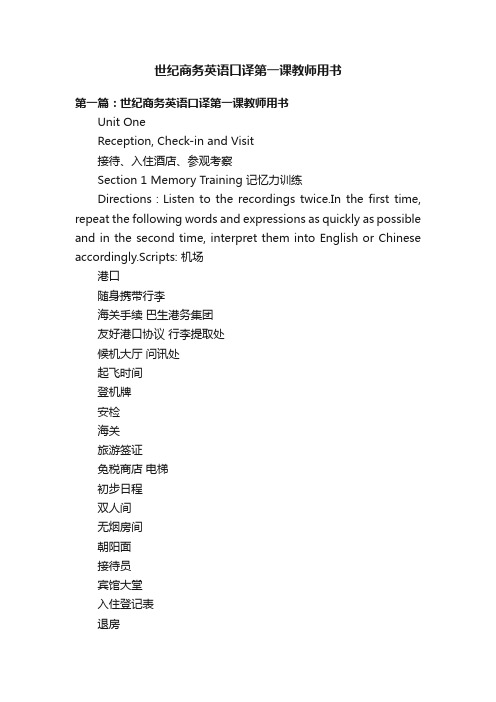
世纪商务英语口译第一课教师用书第一篇:世纪商务英语口译第一课教师用书Unit OneReception, Check-in and Visit接待、入住酒店、参观考察Section 1 Memory Training 记忆力训练Directions:Listen to the recordings twice.In the first time, repeat the following words and expressions as quickly as possible and in the second time, interpret them into English or Chinese accordingly.Scripts: 机场港口随身携带行李海关手续巴生港务集团友好港口协议行李提取处候机大厅问讯处起飞时间登机牌安检海关旅游签证免税商店电梯初步日程双人间无烟房间朝阳面接待员宾馆大堂入住登记表退房豪华套房五星级饭店用现金支付马拉松营销合伙企业竞争对手赞助商策略接管总部制作者目录代表团展览会流行服装投资潜在顾客经营范围供应商调研成交量商会single roomitineraryluxury suitecheck in to pay by casha tight schedulenon-smoking room the sunny side receptionist hotel lobby elevatordeparture timeinformation desk room chargeenquiry desk waiting hall luggage tag Sister Port Agreement luggage claim tourist visa terminal buildingboarding passsecurity check customsduty-free shopstar-grade hotel 40 percent discount hotel registration form to go through the registration proceduresinnovationperformance revenuesportswearchannelreference business associatemarket surveyChamber of CommerceDirections: Listen to the recordings twice.In the first time, retell each sentence as quickly as possible in the source language and in the second time, in the target language.Scripts: 1.我订一张去伦敦的票。
商务英语写作训练lesson1

attractive profile and effective description of products are quite helpful; to learn about the development and problems of the company, a business report is a reliable source; to remind someone of something important, leaving a memo for him or her is rather convenient, so on and so forth,all these activities are concerned with writing. Since no deal would be made without writing, it is necessary to be familiar with the essential elements ofeffective business writings.
×
Exit
沟通的形式
• Nonverbal communication • 1.Pictures • 2.Logo • 3.The size of office • 4.Facial expressions • 5.Eye contact • 6.Gestures • 7.Body language
×
世纪商务英语unit 1
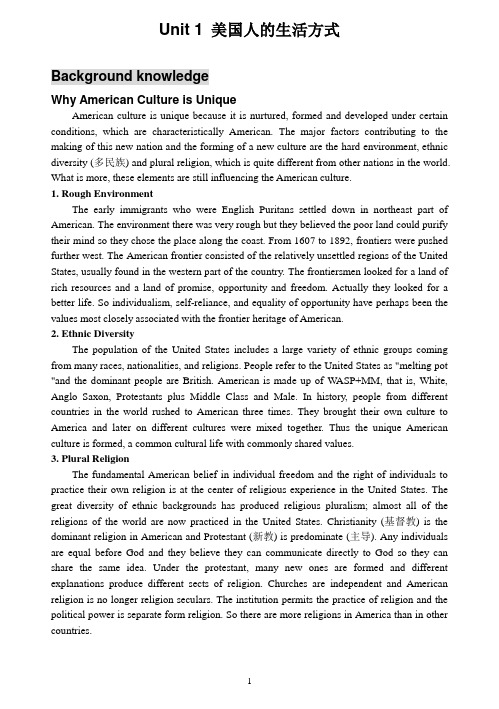
Unit 1 美国人的生活方式Background knowledgeWhy American Culture is UniqueAmerican culture is unique because it is nurtured, formed and developed under certain conditions, which are characteristically American. The major factors contributing to the making of this new nation and the forming of a new culture are the hard environment, ethnic diversity (多民族) and plural religion, which is quite different from other nations in the world. What is more, these elements are still influencing the American culture.1. Rough EnvironmentThe early immigrants who were English Puritans settled down in northeast part of American. The environment there was very rough but they believed the poor land could purify their mind so they chose the place along the coast. From 1607 to 1892, frontiers were pushed further west. The American frontier consisted of the relatively unsettled regions of the United States, usually found in the western part of the country. The frontiersmen looked for a land of rich resources and a land of promise, opportunity and freedom. Actually they looked for a better life. So individualism, self-reliance, and equality of opportunity have perhaps been the values most closely associated with the frontier heritage of American.2. Ethnic DiversityThe population of the United States includes a large variety of ethnic groups coming from many races, nationalities, and religions. People refer to the United States as "melting pot "and the dominant people are British. American is made up of W ASP+MM, that is, White, Anglo Saxon, Protestants plus Middle Class and Male. In history, people from different countries in the world rushed to American three times. They brought their own culture to America and later on different cultures were mixed together. Thus the unique American culture is formed, a common cultural life with commonly shared values.3. Plural ReligionThe fundamental American belief in individual freedom and the right of individuals to practice their own religion is at the center of religious experience in the United States. The great diversity of ethnic backgrounds has produced religious pluralism; almost all of the religions of the world are now practiced in the United States. Christianity (基督教) is the dominant religion in American and Protestant (新教) is predominate (主导). Any individuals are equal before God and they believe they can communicate directly to God so they can share the same idea. Under the protestant, many new ones are formed and different explanations produce different sects of religion. Churches are independent and American religion is no longer religion seculars. The institution permits the practice of religion and the political power is separate form religion. So there are more religions in America than in other countries.4. Current InfluenceNowadays, we can see the continual influence of the three elements in the current American society. American family is typically parents and their unmarried children. Middle-aged and elderly people generally do not live with their married children. Many Americans live in mobile homes which are built with wheels. They can be moved. The people in American have a very strong desire to start a new life in a new place. Quite a number of people change residences every year. The average American moves fourteen times in his lifetime. The courage to try something new has been an American characteristic. American democracy means majority rule, but it also means protection of minority rights. There is certain freedom which the United States promises to all its citizens and members of minority group cannot be denied these rights by a vote of the majority. Americans also like to be involved in many challenging activities and sports to show their adventurous spirits. All of these are affected by the heritage of the American history.From the facts above, we can see American culture is unique which was cultivated, formed and developed by the main three factors, rough environment, ethnic diversity and plural religion and still is affected and determined by them now.Reading Skill Focus1.C Clue:首先,第一句话表明说话人对于后面发生的事情感到非常惊讶。
商务英语写作教程 Unit 1

their analytical skills and help them with their homework. ● Designed tests to chart their progress. ● Created interactive games to increase their understanding of math and grammar.
上看到了如下招聘信息。因此,Alice决定编写一份简历来申请该工作。
Hualin Limited Liability Company We are looking for an executive secretary. College degree and job experience required, perf. Please send resume to Ms. Wang, 23 Gao Street. We will arrange a job interview as soon as possible. Thank you.
除此以外,简历中还可以包含简历标题、求职目标、职涯摘要、职业 技能和个人成就。
1.1 Resume
撰写准备
1. 选择适合的简历类型 2. 查看简历格式、模板和案例 3. 决定简历中要写的内容 4. 定制个人简历 5. 检查简历 6. 修改简历 7. 咨询意见(如需要)
1.1 Resume
撰写格式
Key Holder Amy’s Boutique, Stanford, CA 2013-present ● Opened new specialty boutique ● Placed orders to restock merchandise and handled receiving of products ● Managed payroll, scheduling, reports, email, inventory, and maintained clientele book and records ● Integrated new register functions ● Conducted extensive work with visual standards and merchandising high-ticket items
世纪商务英语口译教程 Unit 1

Mr. Zhang:
哈哈,史密斯先生真幽默!只有贵客才有这种幸运,这说明史密 斯先生是我们的贵客!
Mr. Smith: Mr. Zhang:
Oh, it’s very kind of you to say so. 好,手续都办好了,行李也取了。咱们去宾馆吧?
Mr. Smith: Mr. Zhang:
visit参观考察来料加工processimportedmaterials对销贸易countertrade转口贸易transittrade合理利用外资useforeigncapitalappropriateway边境贸易bordertrade边境互市点bordertradingpost边境口岸borderport国家一级口岸classiport扩大出口能力exportcapacity在经济上具有互补性economicallycomplementary中介服务机构intermediaryservicesagencyvisit参观考察外资项目foreignfundedproject加工厂processingfactoryplant加工费processingchargefee出口加工区exportprocessingzone外向型商品生产基地exportorientedcommodityproductionbase进出口经营权exporttrade公司的经营情况businessperformancecompany根据市场供求关系marketsupplydemand产销结合integrateproductionmarketing缩短产品开发周期shortendevelopmentcyclesnewproducts减少库存积压reduceinventoryvisit参观考察缩短交货日期shortendeliverycyclescustomers供过于求supplyexceedingdemand优质产品highqualityproduct产品工艺products售后服务postaftersaleservice劳务合作laborservicecooperation贸易额tradevolume收支平衡expenditure客户clientcustomer公司总部headoffice总裁presidentvisit参观考察首席执行官ceochiefexecutiveofficer总经理managingdirectorgeneralmanager副总经理deputymanagingdirector销售部经理managersalesdepartment
世纪商务英语基础1--教案

Unit 1 商务语言I. Related Background Information1. Alison ThomasAlison Thomas is a professional freelance writer based in Bristol, southwest England. She has written for a wide variety of magazines and newspapers, including national broadsheets. Her work covers a broad field, from personal finance to pottery, from diving to needlework. Her specialist areas are travel, languages, education and business.2. EurophoneEurophone USA, Inc. is a multi-faceted telecommunications company. Since 1991, Europhone has offered a comprehensive range of telecommunications products and services such as:◆Cellular Phones and Accessories◆Mobile partnered network-based communications services in the U.S. and Europe◆Prepaid Phone Cards◆GSM easy roam pre-paid phone cards◆Long Distance Service◆Internet Service Providers / Prepaid Internet Service◆Laptop ComputersEurophone has developed the Europhone Group of Companies (Inc.) with the following operating divisions: Northern Europe, Central Europe, Southern Europe, America, Asia Pacific, Group Products & Services, and Global platform & Internet Services.Europhone uses TDMA, CDMA, and GSM networks in various parts of the country and the globe to deliver high quality digital voice, messaging and data products. The focus is on leading the market through quality of speed and innovation.3. Confucius, Philosopher◆Born: 551 BC◆Birthplace: Lu, China (now Shandong Province)◆Died: 479 BC◆Best Known As: Chinese Sage◆Also Known As: Kong Fu-ZiConfucius was a teacher, scholar and minor political official whose commentary on Chinese literary classics developed into a pragmatic philosophy for daily life. Not strictly religious, the teachings of Confucius were a utilitarian approach to social harmony and defined moral obligations between individuals and social systems. After his death his pupils collected notes on his sayings and doings and recorded them as the Analects. This compilationwas added to over the years, and many sayings attributed to him are probably only loosely based on his teachings. His approach was formalized into a political and religious system during the Han Dynasty in the early part of the third century. It was embraced by subsequent generations and was the “state religion”of China until the latter part of the 20th century. In recent years critics have condemned Confucianism, characterizing its reliance on tradition as an impediment to modernization.“Confucius”is the Latin rendering of his Chinese name, Kong Fu-Zi, which is sometimes also spelled as Kung Fu-Zi, K’ung-fu-tze, or in other variations. The name is unrelated to the martial art known as kung fu.4. Korean languageOfficial language of North Korea and South Korea, spoken by more than 75 million people, including substantial communities of ethnic Koreans living elsewhere. Korean is not closely related to any other language, though a distant genetic kinship to Japanese is now thought probable by some scholars, and an even more remote relationship to the Altaic languages is possible. Korean was written with Chinese characters to stand in various ways for Korean meanings and sounds as early as the 12th century, though substantial documentation is not evident until the invention of a unique phonetic script for it in 1443. This script, now called Hangul, represents syllables by arranging simple symbols for each phoneme into a square form like that of a Chinese character. Grammatically, Korean has a basic subject-object-verb word order and places modifiers before the elements they modify.II. Language PointsText A1. English may be the language of international business but as Alison Thomas reports, it’s not only non-native speakers who need to learn how to use it effectively.本句是由连词but连接的并列句,后半句是强调句,强调主语non-native speakers。
世纪商务英语听说专业篇I unit 1

3. Are the responsibilities divided?
4. Are there any associates? 5. Do associates have any helpers?
Yes, they are helped by engineers, draughts men and so on.
Questions 1. How big is the firm? 2. How many partners are there?
Answers 25 people, in 3 different offices. 2 partners. The senior partner has overall running of the firm. Yes, 3 associates.
Active Listening
A Civil Engineering Partnership
Active Listening
Task One
Section B
Listen to the interview of a small business owner, Terry. Find out the answers to the following questions about Terry’s business.
The plant employs about 3,700 people. 100: 1958: 2001:
The plant employs about 3,700 people.
___________________________________________ the history of Oxford plant of BMW the first Mini prototype was approved ___________________________________________ The new Mini was launched ___________________________________________ the number of Minis produced each week ___________________________________________ ___________________________________________ the number of countries where Minis are sold the number of employees working in Oxford plant ___________________________________________
商务英语写作unit 1
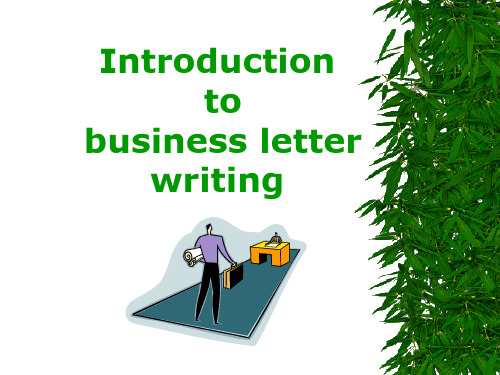
Conclusion
To expect an answer
to expect no answer
9.1Opening
9.1.1 Thanks for receiving a letter
delegations(10%)
Correspondence / Communication in writing ☺ 函:Business letters ☺ 电:Telegrams, telexes, faxes & E-mails
3.The nature & goal of the course
☺ Nature - An English course combining international trade with English.
☺ Goal - To cultivate the ability of negotiating international trade in English, especially in English correspondence.
1) Sender’s name: China National Light Industrial Products Import & Export Corporation, Shanghai Branch
2) Sender’s address: 198 Hunan Road, Shanghai, China 3) Sender’s E mail: shanghai @hotmail 4) Sender’s telephone number: 86 21 66231198 5) Sender’s fax number: 86 21 24317579 6) Sender’s website: slihgc 7) Date: June 23, 2004 8) Receiver’s name: Messrs Jameson & Sons Ltd. 9) Receiver’s address: 34 Madison Square, Melbourne, Australia 10)Salutation: Dear Sirs
世纪英语综合教程1第八版作文
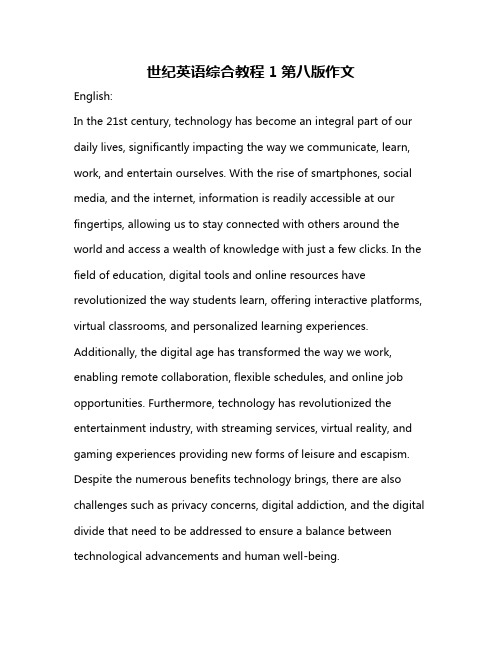
世纪英语综合教程1第八版作文English:In the 21st century, technology has become an integral part of our daily lives, significantly impacting the way we communicate, learn, work, and entertain ourselves. With the rise of smartphones, social media, and the internet, information is readily accessible at our fingertips, allowing us to stay connected with others around the world and access a wealth of knowledge with just a few clicks. In the field of education, digital tools and online resources have revolutionized the way students learn, offering interactive platforms, virtual classrooms, and personalized learning experiences. Additionally, the digital age has transformed the way we work, enabling remote collaboration, flexible schedules, and online job opportunities. Furthermore, technology has revolutionized the entertainment industry, with streaming services, virtual reality, and gaming experiences providing new forms of leisure and escapism. Despite the numerous benefits technology brings, there are also challenges such as privacy concerns, digital addiction, and the digital divide that need to be addressed to ensure a balance between technological advancements and human well-being.中文翻译:在21世纪,技术已经成为我们日常生活的重要组成部分,显著影响着我们的交流方式、学习方式、工作方式和娱乐方式。
世纪商务英语听说教程Ⅰ

( F )3. The library is between the post office and the supermarket.
PartⅠ Training Focus
Section B Locate the Right Place
Directions
Exercise 2 Directions: Look at the map and tell your friend where to go and how to find the place after hearing wha.
A.( Peter) B.( Mary ) C.(Betty ) D.(Steve) E.( Linda ) F.( Jack )
G.( john )
PartⅠ Training Focus
Section B Locate the Right Place
Directions
Exercise 1 Directions: Study the map before listening to the speaker giving directions to different places on the map. Then decide whether each statement is true (T) or false (F).
3. To be able to ask for and give directions.
Contents
Part Ⅰ Part Ⅱ Part Ⅲ Part Ⅳ Part Ⅴ
- 1、下载文档前请自行甄别文档内容的完整性,平台不提供额外的编辑、内容补充、找答案等附加服务。
- 2、"仅部分预览"的文档,不可在线预览部分如存在完整性等问题,可反馈申请退款(可完整预览的文档不适用该条件!)。
- 3、如文档侵犯您的权益,请联系客服反馈,我们会尽快为您处理(人工客服工作时间:9:00-18:30)。
About Positive and Negative Language
Group 1: Unfortunately, your order cannot be sent until next week. Your misunderstanding of our January 8 letter caused you to make this mistake. We regret to inform you that we must deny your request for credit. Group 2: Your order can be sent next week. If you had understood our January 8 letter, you have done it correctly. For the time being, we can serve you only on a cash basis.
Basic Patterns of Business Writing
Business messages can be organised either deductively(演绎法) direct order or inductively(归纳法)indirect order, depending on your prediction of the receiver’s reaction to your main idea. When you are going to send good-news and routine messages, deductive approach( direct order) should be adopted. When sending bad-news (negative) messages or trying to persuade the reader, inductive approach (indirect order) should be adopted. To inform to persuade to entertain
Criteria of Effective Business Writing
Remember seven C’s principles: courtesy, correctness, conciseness, clarity, concreteness and completeness. Try to get to know what every criterion means.
Lesson 1 An Overview of Business Writing
商务写作概述
Focus of This Chapter
Criteria for effective business writing The concept of you-attitude/viewpoint Difference between positive language and negative language Two approaches to organize business messages
About you-attitude/viewpoint
What does you-attitude/viewpoint mean? To focus interest on the reader, that is to emphasize the reader’s interest and concerns. It also means second person pronoun “you” should be used in writing. However, when using you-view point in writing, a writer should avoid insincerity.
About பைடு நூலகம்ou-attitude/viewpoint
The key is that to treat the reader courteously – the way he or she likes to be treated. Compare the following letters: Letter A: We have received your request for permission to use our computers during the next session for summer school. We are pleased to inform you that you may use all 15 of the laptop computers you requested. Would you please come in and fill out the necessary paperwork any time before April? Letter B: Good news, Jessica! All 15 of the laptop computers you requested will be available to use during the next session of summer school. Please come by the office before April 1 to fill out the necessary forms.
About Positive and Negative Language
What is the difference between positive language and negative language? Positive language emphasizes the pleasant aspects of the goal and tend to put the reader in good mood. It tends to use positive words. While, negative language is going to send negative message (or to say no), which tends to use negative words, such as not…until, can not, no, not. Read the following groups:
